沪教牛津版小学四年级英语上册全册教案
- 格式:docx
- 大小:114.54 KB
- 文档页数:67
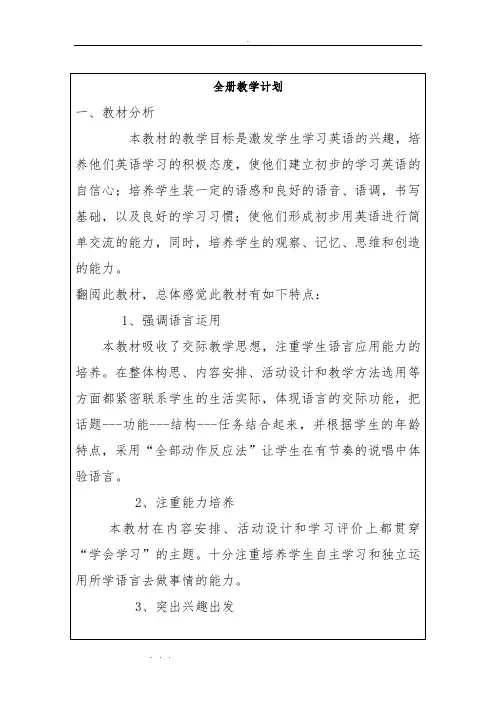
《 Unit1 Meeting new people 》第( 1 )课时《 unit1 Meeting new people 》第( 2 )课时《 Unit2 Can you swim 》《 Unit2 Can you swim ? 》第( 2 )课时《 Unit3 Are you happy 》《 Unit 3 Are you happy? 》第( 2 )课时《 Unit4 Do you have any cousins 》第( 1 )课时《Unit4 Do you have any cousins》第( 2 )课时《 Unit5 My freind 》《 Unit5 My friend 》第( 2 )课时《 Unit6 My parents 》chorally and individually .3).Pair the students to ask and answer .4).Put the students in new pairs ,have them do a mingling activity, asking the person nearest them when you clap your hands .学生活动 1).Work in pairs about their name .country .age or other more .2).Act out the conversation in font in pairs.2、Reading extensively /In put活动目的 Train students to get specific information through reading .教师活动 1).Ask students to read and answer individually.2). Ask them to check with a partner .3).Call back the answers from the whole class ,asking the students to read the statements and then say “true”or “false”.学生活动 1).Read and answer individually, then check with a partner .2).Check the answers in class and share the learning strategy .3)Correct the false sentences .3、Reading intensively/Practice活动目的 1) Use the words they have just learned in real life .2)Teach students writing skills .教师活动 1).Ask the students to read the passage in activity 2 again and to fill in the table with correct information .2) .Check the answers with wholeclass ,then with individual students .3). Ask students to describeDaming .Lingling .andWang hui by themselves,then ask some students to the front to talk about them .学生活动 1) .Read the passage carefully again and do activity 3—complete the table.2). Check the answers with apartner ,then with the whole class .3).Try to say something about《 Unit6 My parents 》第( 2 )课时《 Unit 7 At school 》《Unit 7 At school》第( 2 )课时。
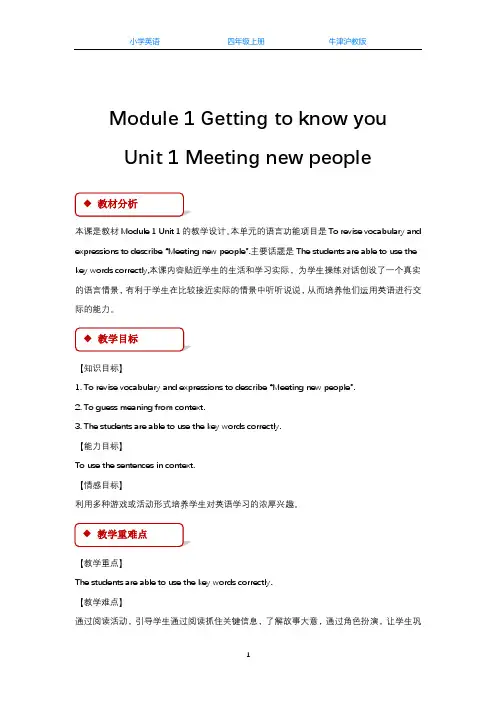
Module 1 Getting to know youUnit 1 Meeting new people本课是教材Module 1 Unit 1的教学设计。
本单元的语言功能项目是To revise vocabulary and expressions to describe “Meeting new people”.主要话题是The students are able to use the key words correctly,本课内容贴近学生的生活和学习实际,为学生操练对话创设了一个真实的语言情景,有利于学生在比较接近实际的情景中听听说说,从而培养他们运用英语进行交际的能力。
【知识目标】1. To revise vocabulary and expressions to describe “Meeting new people”.2. To guess meaning from context.3. The students are able to use the key words correctly.【能力目标】To use the sentences in context.【情感目标】利用多种游戏或活动形式培养学生对英语学习的浓厚兴趣。
【教学重点】The students are able to use the key words correctly.【教学难点】通过阅读活动,引导学生通过阅读抓住关键信息,了解故事大意,通过角色扮演,让学生巩固和运用本单元所学核心词汇和句型。
Tape recorder, Multimedia.Step 1. Warm up1. Listen and sayT: What do you know about “Meeting new people”?Look at the pictures on P2 and PPT. Talk about “Meeting new people”.To introduce them to the topic. And encourage them to talk about the topic.2. ListeningPlay the listening materials, stop when necessary. And then check the answers.To train the students’ ability of catching the information of the listening materials.Step 2. Presentation1. Look and learnLead them to read and explain the “Meeting new people”.e.g: This is your new classmate, his name is...2. Make and say(1) Learn the rules in P3.(2) Finish the exercise on P3 and group work to work out the usage method of the “Meeting new people”.(3) Walk around to exam the situation and check the answers for them.(4) List the method of for them.(5) To develop their interests and lead them to the conclusion.Step 3. Practice1. Say and actLet the students look PPT and act the scene.To make them get familiar with the details of the text and train their ability of saying and reading.2. Sing a song(1) Let the students look PPT and sing a song.(2) Let the students get the general idea of the text.3. Learn the letters(1) Learn the letters in P5.(2) List the letters for them.(3) To develop their interest and lead them to the conclusion.Step 4. Homework1. Dictation.2. Use the new words to make sentences on your own or check them in a dictionary.略。
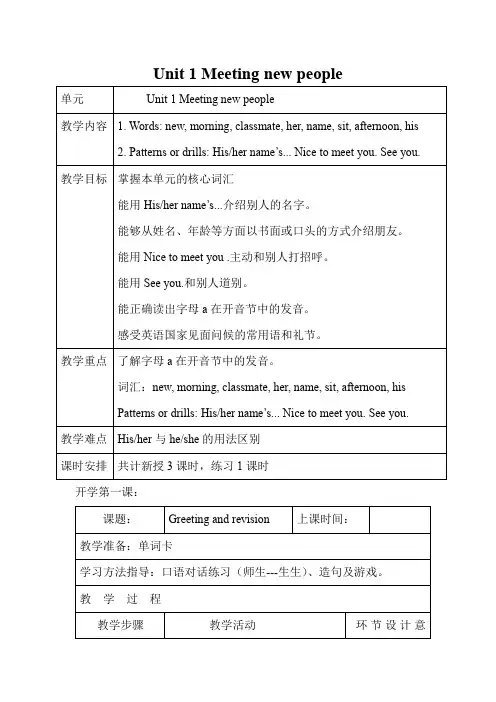
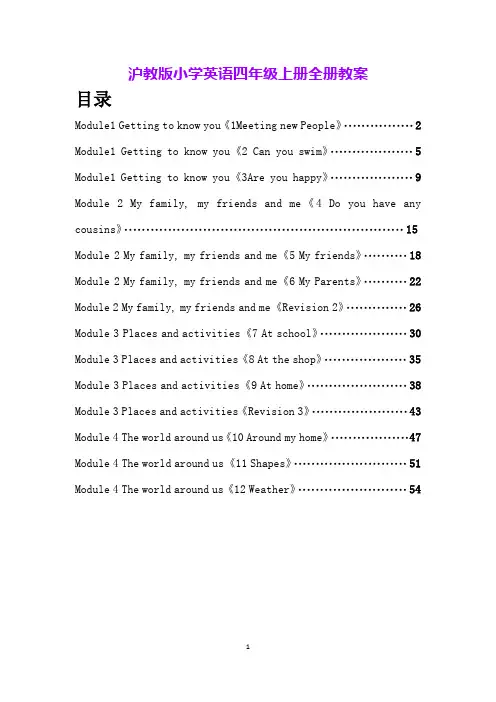
沪教版小学英语四年级上册全册教案目录Module1 Getting to know you《1Meeting new People》 (2)Module1 Getting to know you《2 Can you swim》 (5)Module1 Getting to know you《3Are you happy》 (9)Module 2 My family, my friends and me《4 Do you have any cousins》 (15)Module 2 My family, my friends and me《5 My friends》 (18)Module 2 My family, my friends and me《6 My Parents》 (22)Module 2 My family, my friends and me《Revision 2》 (26)Module 3 Places and activities《7 At school》 (30)Module 3 Places and activities《8 At the shop》 (35)Module 3 Places and activities《9 At home》 (38)Module 3 Places and activities《Revision 3》 (43)Module 4 The world around us《10 Around my home》 (47)Module 4 The world around us《11 Shapes》 (51)Module 4 The world around us《12 Weather》 (54)Module1 Getting to know you《1Meeting new People》1教学目标本节课是4A Module1 Unit1 Meeting new people的第一课时。
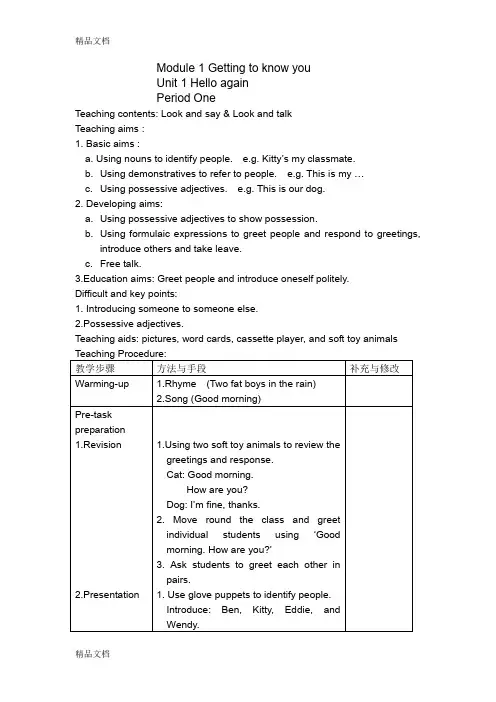
Module 1 Getting to know youUnit 1 Hello againPeriod OneTeaching contents: Look and say & Look and talkTeaching aims :1. Basic aims :a. Using nouns to identify people. e.g. Kitty’s my classmate.b. Using demonstratives to refer to people. e.g. This is my …c. Using possessive adjectives. e.g. This is our dog.2. Developing aims:a. Using possessive adjectives to show possession.b. Using formulaic expressions to greet people and respond to greetings,introduce others and take leave.c. Free talk.cation aims: Greet people and introduce oneself politely.Difficult and key points:1. Introducing someone to someone else.2.Possessive adjectives.Teaching aids: pictures, word cards, cassette player, and soft toy animalsPeriod TwoTeaching contents: Read a story & Learn the soundTeaching Aims:1. Basic aims:a. Using verbs to describe actions. e.g. run, swim, jumpb. Using modals to talk about ability. e.g. She can run.c. Using connectives to link contrasting ideas e.g. But she can’t cook.d. Saying the sound ‘ch-‘2. Developing aims:a. Read and act the storyb. Talking about ability.c. Write a simple story.Teaching aids: pictures, word cards, cassette player, and maskPeriod ThreeTeaching contents: Look and say & Ask and answerTeaching aims:1.Basic aims:a. Using verbs to describe actions. e.g. paint, readb. Using interrogatives to ask ‘yes/no’ -questions to obtain simple responses.e.g. Can you swim?c. Using modals to talk about ability.e.g. Yes, I can. / No, I can’t.2 .Developing aims:a. Asking about ability.b. Do a survey in class.cation aims: Talking about ability to establish friendly relations with yourclassmates.Teaching aids: pictures, word cards, cassette player,Module 1 Getting to know you Unit 2 How old are you?Period OneTeaching contents: Look and say. Ask and answerTeaching aims:1.Basic aim: 能听懂,会说,会读本课对话. E.g. How old …? Happybirthday. Thank you.2.Education aim: 会相互询问对方年龄,庆贺对方生日,增进感情。
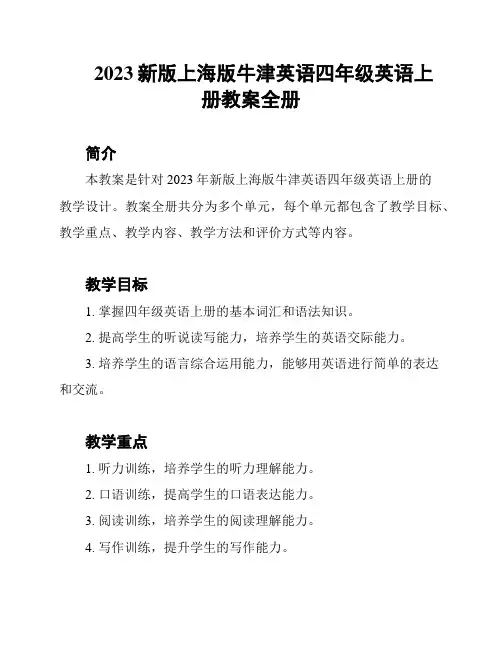
2023新版上海版牛津英语四年级英语上册教案全册简介本教案是针对2023年新版上海版牛津英语四年级英语上册的教学设计。
教案全册共分为多个单元,每个单元都包含了教学目标、教学重点、教学内容、教学方法和评价方式等内容。
教学目标1. 掌握四年级英语上册的基本词汇和语法知识。
2. 提高学生的听说读写能力,培养学生的英语交际能力。
3. 培养学生的语言综合运用能力,能够用英语进行简单的表达和交流。
教学重点1. 听力训练,培养学生的听力理解能力。
2. 口语训练,提高学生的口语表达能力。
3. 阅读训练,培养学生的阅读理解能力。
4. 写作训练,提升学生的写作能力。
教学内容本教案的教学内容主要包括以下几个方面:1. 单词研究:研究新单词,并进行听写和造句练。
2. 句子练:研究常用句型,并进行口语练和问答练。
3. 阅读理解:通过阅读短文和练题,提高学生的阅读理解能力。
4. 听力练:通过听力材料和听力题目,提升学生的听力理解能力。
5. 写作训练:通过写作练题,提升学生的写作能力和表达能力。
教学方法根据学生的英语水平和研究特点,本教案采用了多种教学方法,如游戏教学、小组合作研究、听说训练等,旨在激发学生的研究兴趣,提高研究效果。
评价方式本教案的评价方式主要包括以下几个方面:1. 日常评价:通过观察学生的课堂表现和作业完成情况,评价学生的研究态度和研究效果。
2. 小测验:定期进行小测验,检测学生对所学知识的掌握情况。
3. 期末考试:通过期末考试,综合评价学生的英语水平和研究成果。
以上是2023新版上海版牛津英语四年级英语上册教案全册的简要介绍。
祝您教学顺利!。


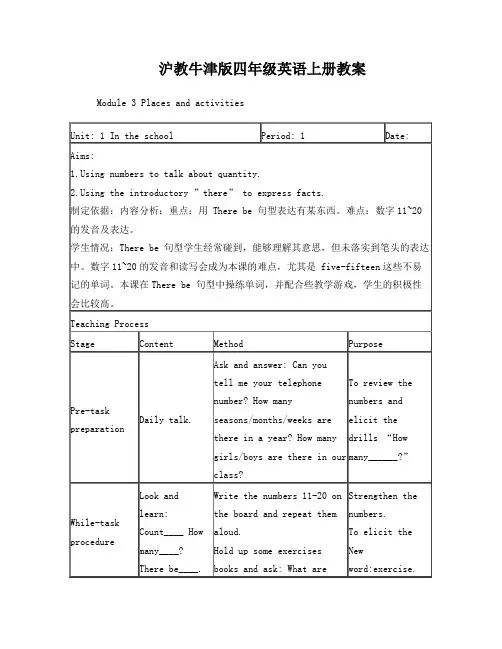
沪教牛津版四年级英语上册教案Module 3 Places and activities牛津小学英语4A《Unit4 I like…》说课稿一、教学过程【教学内容分析: Unit4通过教学What’s this/that in English?It’s a…使学生在学习的过程中能运用这些对话向周围的老师同学和朋友请教,从而促进英语学习。
除此之外,还要求学生能用Do you like …?Yes,I do./No, Idon’t.的句式了解对方对某物是否喜欢。
基于此,结合本单元 A. Read and say , B. Look. read and learn的内容较多,故选A中的1、2、3幅图和B中的部分单词安排在第一课时教授。
】anization1. Greetings.2. Sing songs and say rhymes:《Are you sleeping?》、《A little book》、《Do you like swimming?》组织教学:师生交流,通过师生相互问好,演唱歌曲《Are you sleeping?》(为后面的老曲新唱作铺垫)、《A little book》(最后一句诗是I like 后加某物,跟新课有关)、《Do you like swimming?》(为了复习Do you like…?),营造一种轻松的学习氛围,学生可以边唱边表演,这样就很快进入一种自觉的语言状态。
在歌曲的安排上,做到与本节课的教学有联系。
3. Acting reports: three conditions (on Teachers’ Day;In the classroom; In the zoo)复习引入:首先,提供三个情景,让学生表演对话,既是带领学生复习,同时也是对学生英语能力的一种展示。
Step2.Presentation and practise1. show some pictures and review the sentences: What’s this/that in English? It’s a….2. use the things on the desk and practise( T—Ss; boys—girls; S—S; in groups; in pairs)其次,通过一些图片、实物的出示,结合句型What’s this/that in English? It’s--- 进行连锁操练。
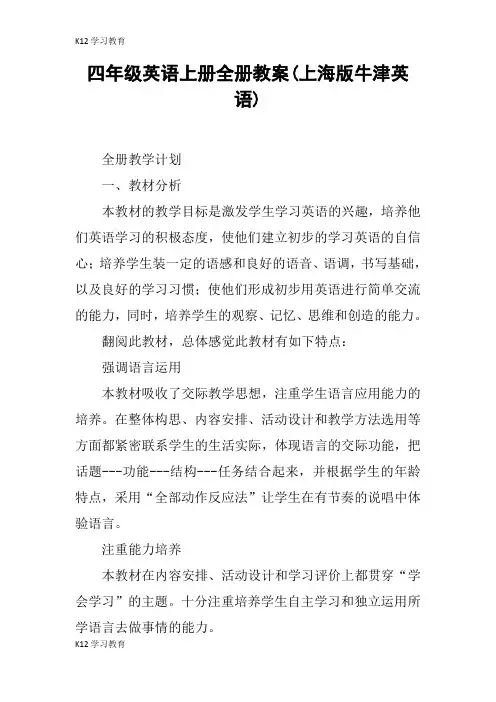
四年级英语上册全册教案(上海版牛津英语)全册教学计划一、教材分析本教材的教学目标是激发学生学习英语的兴趣,培养他们英语学习的积极态度,使他们建立初步的学习英语的自信心;培养学生装一定的语感和良好的语音、语调,书写基础,以及良好的学习习惯;使他们形成初步用英语进行简单交流的能力,同时,培养学生的观察、记忆、思维和创造的能力。
翻阅此教材,总体感觉此教材有如下特点:强调语言运用本教材吸收了交际教学思想,注重学生语言应用能力的培养。
在整体构思、内容安排、活动设计和教学方法选用等方面都紧密联系学生的生活实际,体现语言的交际功能,把话题---功能---结构---任务结合起来,并根据学生的年龄特点,采用“全部动作反应法”让学生在有节奏的说唱中体验语言。
注重能力培养本教材在内容安排、活动设计和学习评价上都贯穿“学会学习”的主题。
十分注重培养学生自主学习和独立运用所学语言去做事情的能力。
突出兴趣出发本教材从内容、形式、方法、插图及装帧设计等方面都以最大限度地激发学生的学习动机和兴趣。
教学内容紧密联系学生装生活与实际。
选择话题充分考虑小学生的需求。
重视双向交流本教材重视双向交流,中西方文化知识的渗透,在教学内容中选编了一些适合学生年龄特点和认知能力的中西方文化知识。
本教材十分重视在学习内容上与其他学科知识的兼容闭并蓄,精选需要兴趣的,最易学会的,最有普及价值的,与学生日常生活联系最紧密。
本教材采用了“教案式”的编排体系。
每册书有四个模块,共12个单元。
二、学生情况分析四年级的学生已经接受了一年的英语学习,掌握了一定量的英语词汇和基础的英语会话。
故本学期将进一步培养其英语学习的兴趣与运用英语的基本技能。
在词汇教学和会话教学的基础上,扎实进行字母的四会教学。
二、教学目标与要求能听懂、会说12组会话,并能进行简单的交流。
能听、说、认读66个单词和听、说、读、写26个字母并且能听、说、读写36个单词。
能听、做、演18个游戏。
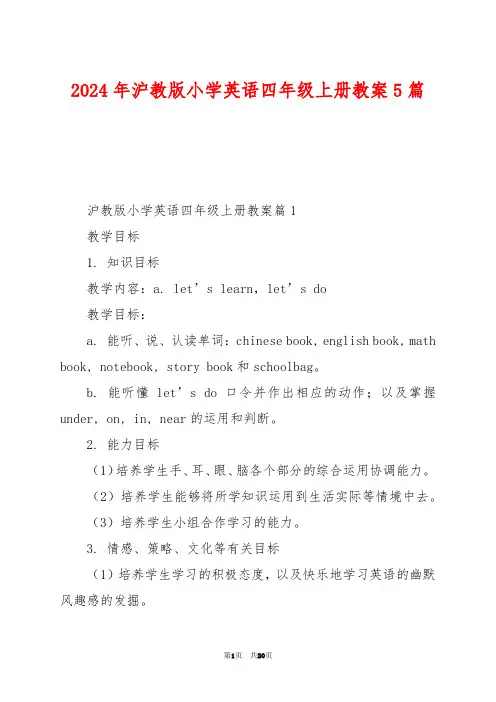
2024年沪教版小学英语四年级上册教案5篇沪教版小学英语四年级上册教案篇1教学目标1. 知识目标教学内容:a. let’s learn,let’s do教学目标:a. 能听、说、认读单词:chinese book, english book, math book, notebook, story book和schoolbag。
b. 能听懂let’s do 口令并作出相应的动作;以及掌握under, on, in, near的运用和判断。
2. 能力目标(1)培养学生手、耳、眼、脑各个部分的综合运用协调能力。
(2)培养学生能够将所学知识运用到生活实际等情境中去。
(3)培养学生小组合作学习的能力。
3. 情感、策略、文化等有关目标(1)培养学生学习的积极态度,以及快乐地学习英语的幽默风趣感的发掘。
(2)培养学生积极运用所学的语言进行表达和交流,注意观察生活及运用所学英语知识,鼓励学生自主、合作、探究的学习行为。
二、教学重、难点重点a:听、说、认读相关单词。
重点b:根据指令熟练地做出相应动作,以及掌握under,on,in,near的运用和判断三、课前准备a:教师准备语文书、数学书、英语书、笔记本、故事书各一本,一个书包,几件衣服和文具用品。
b:教师准备录音机和磁带。
c:学生准备好自己的书包、各类书和文具。
四、教学步骤step 1.热身t: hello, boys and girls. i’m very happy to be here today. your school is so big and beautiful. the classroom is so new. the new …s: the new desk, new chair, new door, new board, new window…t: good! so, i want to ask you a question. how many windows can you see? how many?s: one, two, three, four, five, six. we can see six windows.task 1:t: excellent! (从口袋中拿出尺子) what’s this?s:it’s a ruler.t: (再拿一把)s:two rulers.t: (再拿一把)s: three rulers.t: (再拿一把)t: (再摸一摸)s: four rulers.(其实没有了)t: no, that’s all i have. so i have three rulers. how many rulers do you have?s: i have …(借班上课,先通过对话拉近与学生的距离。
Module 1 Unit 1 教案1一、教学重点词汇:morning,afternoon日常用语:Nice to meet you.二、教学栏目Look and learn,Listen and enjoy三、教学目标1. 帮助学生学Look and learn中的单词。
2. 通过Listen and enjoy的儿歌,帮助学生学习日常用语Nice to meet you.,感受单元话题。
四、教学步骤Pre-task preparations1. 用Hello! Hi! 等招呼语和学生打招呼,鼓励学生尽量用英语提问了解老师的情况。
如:How old are you? What do you like? 等等,增进师生之间的了解。
根据学生的提问进行简单的自我介绍。
然后告诉学生你的名字,帮助学生理解单词name的含义。
T: Hello.S1: Hello.T: I’m your (new) English teacher.My name’s …接着,让学生理解My name’s …的意思,然后请学生用My name’s …在小组内介绍自己的姓名。
2. 出示Listen and enjoy栏目的图片,请学生边看图片边听录音。
听完后,教师微笑着和一位学生握手,说Nice to meet you.,通过“握手、问候”的动作让学生明白Nice to meet you. 的意思,重复几遍,请全班学生跟读Nice to meet you. 然后让学生跟读儿歌并模仿录音的语音语调,鼓励学生边说儿歌边做互相问候的动作。
While-task procedures1. 拿着Look and learn的morning图片,用Good morning. 向学生问候,让学生听清并理解morning的含义,再跟着教师读。
T: Good morning, boys and girls.(show the flashcard for morning) Morning.Ss: Morning.T: M-O-R-N-I-N-G, morning.Ss: M-O-R-N-I-N-G, morning.接着,向不同的学生用Good morning. 问好,如向一个学生问好,或向全体男生、女生问好,引导学生用Good morning, …来回答。
《 Unit1 Meeting new people 》第(1 )课时《 unit1 Meeting new people 》第( 2 )课时《 Unit2 Can you swim 》《 Unit2 Can you swim ? 》第( 2 )课时《 Unit3 Are you happy 》《Unit 3 Are you happy? 》第(2 )课时《 Unit4 Do you have any cousins 》第( 1 )课时《Unit4 Do you have any cousins》第( 2 )课时《 Unit5 My freind 》《Unit5 My friend》第(2 )课时《 Unit6 My parents 》pairs.2、Reading extensively /In put活动目的 Train students to get specific information through reading .教师活动 1).Ask students to read and answer individually.2). Ask them to check with a partner .3).Call back the answers from the whole class ,asking the students to read the statements and then say “true”or “false”.学生活动 1).Read and answer individually, then check with a partner .2).Check the answers in class and share the learning strategy .3)Correct the false sentences .3、Reading intensively/Practice活动目的 1) Use the words they have just learned in real life .2)Teach students writing skills .教师活动 1).Ask the students to read the passage in activity 2 again and to fill in the table with correct information .2) .Check the answers with wholeclass ,then with individual students .3). Ask students to describeDaming .Lingling .andWang hui by themselves,then ask some students to the front to talk about them .学生活动 1) .Read the passage carefully again and do activity 3—complete the table.2). Check the answers with apartner ,then with the whole class .3).Try to say something about Daming,Lingling ,and wang hui.First,prepare by themselves thentry to talk about them to the front .4、Writing /Out put活动目的 1).Train Ss writing skills .2).Review the knowledge learned教师活动 1).Ask a few student to try to say something about Jiang li ,then write down the sentences about jiangli .《Unit6 My parents 》第( 2 )课时《 Unit 7 At school 》《Unit 7 At school》第( 2 )课时。
沪教牛津版小学四年级英语教学设计目录Unit1 Meeting new peopleUnit2 Can you swimUnit3 Are you happyUnit4 Do you have any cousinsUnit5 My friendsUnit6 My parentsUnit7 At schoolUnit8 At the shopUnit9 At homeUnit10 Around my homeUnit11 ShapesUnit12 WeatherMeeting new people3)语法:1. 形容词性物主代词my, her, his, your在英语中有物主代词,它可以分成名词性的和形容词性的。
形容词性物主代词相当于形容词,置于名词前,在句子中用于修饰名词,做定语,后面必须跟一个名词。
例如:This is my brother. His name is Tom. 这是我的哥哥。
他叫汤姆。
形容词性物主代词有人称和数的变化,单数形式:my(我的),your(你的),his /her/its(他的、她的、它的)。
复数形式:our(我们的),your(你们的),their(他们的)。
练习:1. This is my book. are over there.A. YourB. YoursC. YouD. Mine2. Whose pen is it? It’s .A. herB. hersC. sheD. his3. __bag is new and __is new, too.A. Our, heB. Ours, hisC. My, hisD. My, her4. This room is ours, and that one is __.A. theyB. themC. theirsD. their5. Whose pencils are there? They’re __.A. myB. meC. mineD. our6. Is the new watch __? Yes, it’s __.A. you, meB. yours, mineC. your, myD. your, mine7. Whose shoes are these? They are __.A. meB. mineC. myD. I8. She is a student , __name is Han Mei.A. itsB. herC. hersD. his9. It’s a dog. I don’t know __name.A. its’B. itsC. itD. it’s10. This ruler isn’t mine. I think it is __.A. heB. himC. hisD. her11.__schoolbag is beautiful. But __is more beautiful.A. Jims, myB. Jim’s, mineC. Jim’s, meD. Jims’, I12. __am a boy and __is a girl.A. My, sheB. I, herC. I, sheD. Mine, she13.I like __new dress.A. SheB. herC. hersD. his14.I often help __mother do __housework(家务活)。
4AM1U1 Meeting new people 单元设计(主备人:)单元任务分析该单元的主题为meeting new people,要求学生掌握的核心词汇是数词:eleven, twelve, thirteen, fourteen, fifteen, sixteen,可根据不同学校的具体情况拓展至hundred。
主要句型是His\Her name is…而his\her 的用法也是本单元的重点。
能从外表、能力等方面描述自己的朋友,班级里的新同学,并通过介绍朋友、新同学掌握his\her的用法。
除了核心词之外,本单元的新词汇和新词组难度比较大,包括student number, live near, walk to school,be going to 这些单词和词组虽然不是核心词汇,但是在做介绍以及日常交流中实际使用价值较大,可结合学生的实际情况进行教学,使学生可以做到运用这些词汇进行简单交流。
对自己的朋友和新同学的介绍是本单元的重点。
学生已经可以用简单句型进行介绍,比如He\She is...He\She can...在这样的基础上引导学生更加全面有顺序的进行介绍,从姓名、外表、能力、爱好等方面入手,使语段更加丰满。
并能正确使用物主代词his\her来描述姓名、外貌、学号等。
可以引导学生珍惜身边的好朋友,善待新同学并学会相互尊重和欣赏。
单元教学目标通过本单元的学习,学生能:1.掌握数词eleven, twelve, thirteen, fourteen, fifteen, sixteen,能认读一百以内的整数;2.复习招呼语的各种表达;3.能使用his\her等物主代词描述一个人的名字,外表,学号等等,如his hair\eyes…4.正确使用词组:student number, live near, walk to school,be going to5.了解和感知-sk在单词中的发音,并能正确发【sk】。
《 Unit1 Meeting new people 》
See you. 再见。
- Nice to see you. 很高兴见到你。
- Nice to see you too. 也很高兴见到你。
基于课本进行讲解。
Part 1: Look and say
Good morning, Peter.
Good morning, Kitty.
This is my sister. Her name is
Sally. Shes twelve.And his my brother. His na me is Paul. He’s only six.
Hi, Sally. Hi, Paul. My name is Kitty.
I’m Peter
Hi, Kitty.
We are going to the park. Goodbye, Kitty. Part 2: Ask and answer
Show a photo of your friend.
Then talk about him/ her.
This is my friend. His name is Danny.
Heis nine. He can ride a bicycle. This is my friend. Her name’s Tracy. She’s thirteen. Sh e can skip.
S: This is my ... His /Her name’s ...
He’s/ She’s ... (age)
He / She can ...
3)语法:
1. 形容词性物主代词
my, her, his, your
在英语中有物主代词,它可以分成名词性的和形容词性的。
形容词性物主代词相当于形容词,置于名词前,
在句子中用于修饰名词,做定语,后面必须跟一个名
词。
例如:
This is my brother. His name is Tom.
这是我的哥哥。
他叫汤姆。
形容词性物主代词有人称和数的变化,
单数形式:
my(我的)your(你的)
his /her/its
(他的、她的、它的)
《 unit1 Meeting new people 》
第( 2 )课时
《 Unit2 Can you swim 》
第( 1 )课时
第( 2 )课时
《 Unit3 Are you happy 》
《 Unit4 Do you have any cousins 》
《 Unit5 My freind 》第( 1 )课时
第(2 )课时
《 Unit6 My parents 》
第( 2 )课时
Unit 7 At school 第( 2 )课时
板书 设计
Unit8 At the shop
carrot s A: What would you like? tomato es B: I’d like some potatoes potato es cabbage s
fish meat rice 教学 反思
《 Unit8 At the s hop 》
第( 2 )课时
三 维 目 标
1.帮助学生学习元音字母o 在闭音节中的发音。
2.通过阅读Panda ’s glasses shop,帮助学生进一步巩固和运用核心句型。
3.通过学习任务,帮助学生巩固和综合运用本单元所学的知
识。
学习重点 语音:o(dog,shop) 词汇:toghter 日常用语:Can I help you?
学习难点 句型I ’d like a pair of big/small glasses. 教具准备
单词卡片 挂图
课堂教学活动设计
二度备课
评价区:
1 2 3 4
《Unit 9 At home 》第( 1 )课时
Unit 9 At home 第(2)课时。